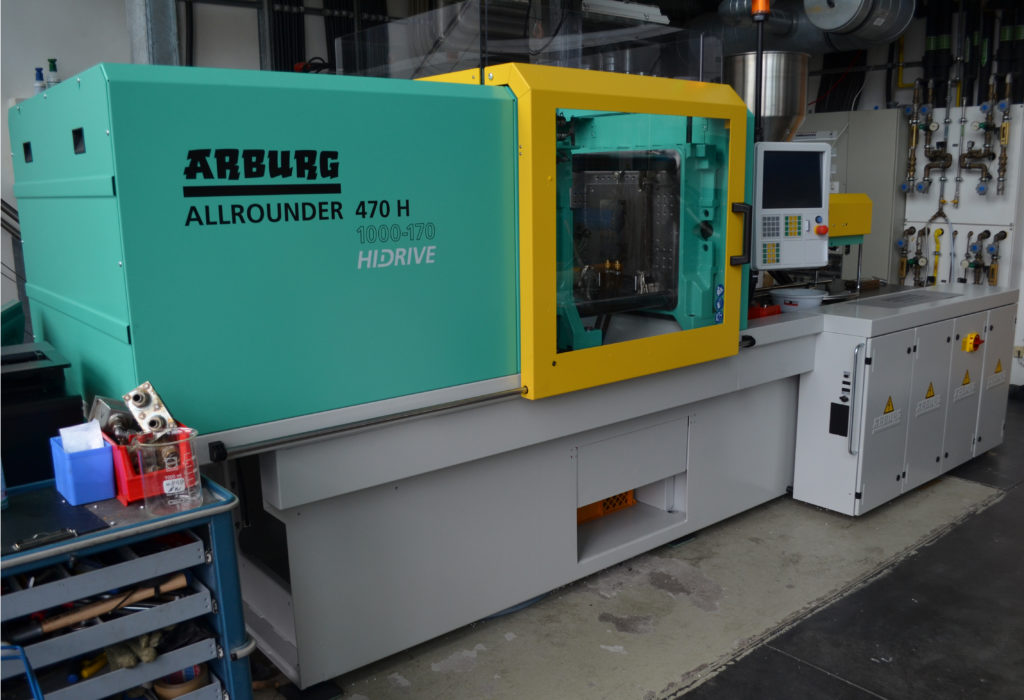Foam Processing
Foaming polymers by batch and continuous processes
The production of polymer foams is one of our areas of expertise. In this regard, we are versed in a variety of processes for the production of autoclave, particle, extrusion, and injection moulded foams. Foams of various structures can be produced using the right production parameters and targeted material modification. The spectrum ranges from standard plastics to high-temperature thermoplastics.
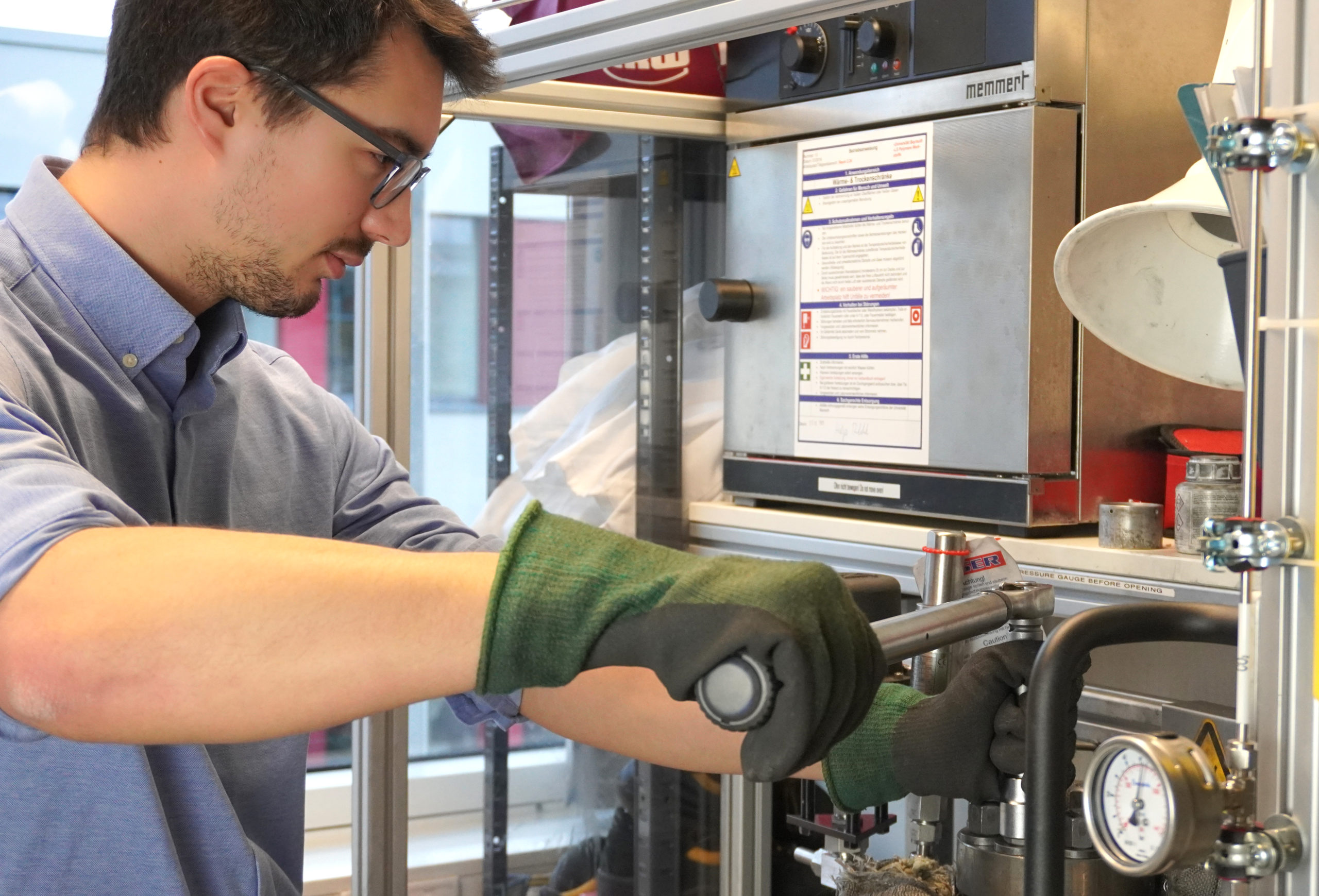
Contact: Marcel Dippold, M.Sc.
Phone: +49 921 55 7481
Mail: Marcel.Dippold@uni-bayreuth.de
The batch process is a discontinuous process, which has very good reproducibility due to its precise process control. It is particularly suitable for investigating the foaming behaviour of new polymer systems, but is also used industrially for foam production. Physical blowing agents such as gaseous or supercritical CO2 are used as blowing agents in this process.
The high-pressure autoclave, allows polymers to be foamed using the pressure-spring method. With this autoclave, materials are loaded with blowing agents under very high pressures and temperatures. After the required loading time, samples are foamed by a rapid pressure drop (=high pressure drop rate). During the entire test period, all relevant data such as the temperature and pressure curve and the pressure drop rate are recorded.
Maximum Pressure [bar] 200
Maximum Temperature [°C] 300
Volume [ml] 100
Chamber dimensions (diameter [mm] x height [mm]) 50 x 50
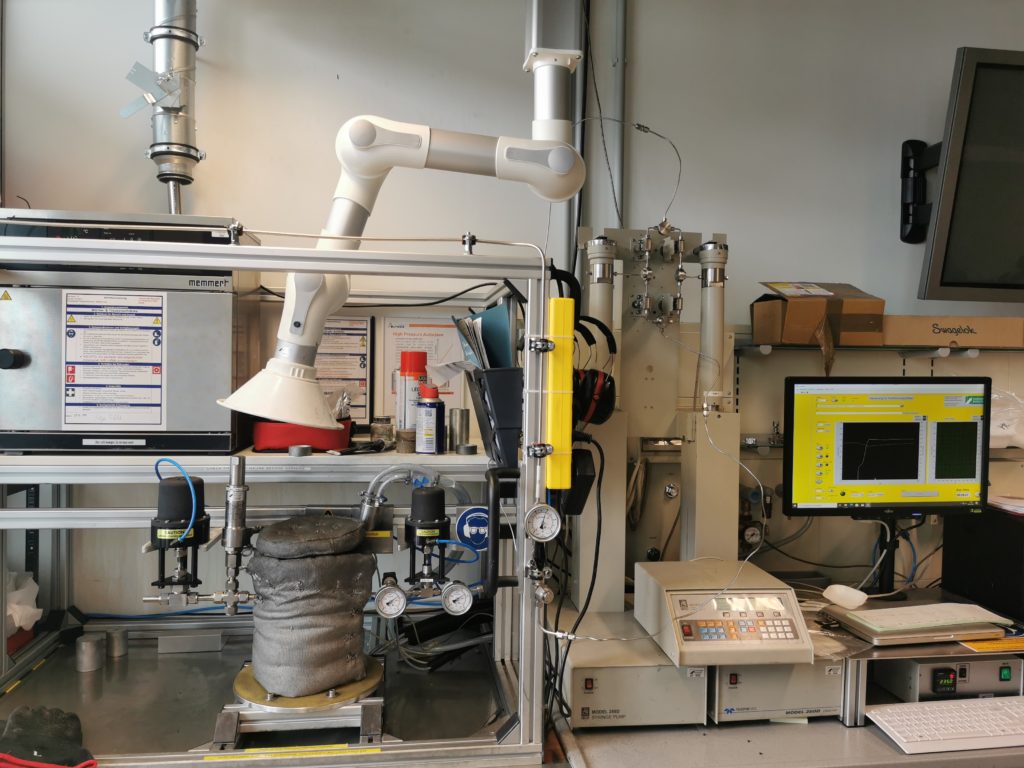
The batch process is a discontinuous process featuring very good reproducibility due to its precise process control. The process is particularly suitable for investigating the foaming behaviour of new polymer systems, but is also used industrially for foam production. Physical blowing agents such as CO2 are used as blowing agents in this process. Basically, a distinction can be made between two foaming methods, the pressure jump and the temperature jump method. The temperature jump method is a fast procedure for initial screening tests of materials, with which significant effects such as nucleation can be detected.
We use the laboratory autoclave to investigate the foaming behaviour of polymers using the temperature jump method. In this autoclave, materials can be loaded with the blowing agent specified under the required pressure and temperature. Subsequently, samples can be foamed in an oil bath.
Maximum Pressure [bar] 200
Maximum Temperature [°C] 230
Volume [ml] 700
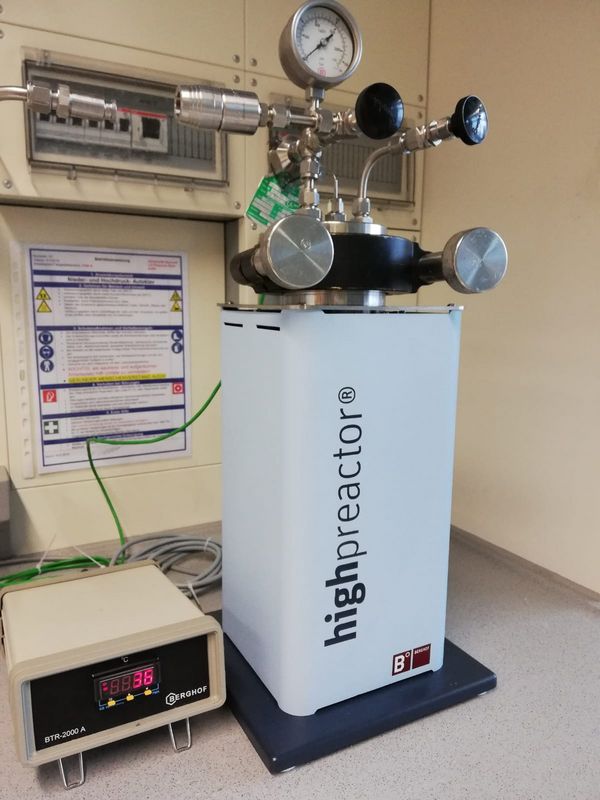
The agitated autoclave and adapted expansion tank (INOX) represents a suitable tool for the production of particle foams, analogous to expanded polypropylene (EPP), on a laboratory scale. With this tool, granulate quantities up to a maximum of 500 g (usually 50 – 200 g) can be impregnated with a suitable physical blowing agent. Short-chain hydrocarbons as well as gases and polar solvents serve as blowing agents. The saturation temperature and the loading time are controlled with the Julabo JU-07 C controller. After a fixed impregnation time with a blowing agent under pressure and temperature, which depends on the type and size of the granulate used, the gas-laden beads can be foamed by abruptly opening a valve (enormous pressure drop) using the pressure jump method. Analogous to the high-pressure autoclave, all process data are recorded.
Maximum Pressure [bar] 70
Maximum Temperature [°C] 200
Volume Loading Tank [L] 2,3
Volume Pressure-relief Tank [L] 15

The automatic moulding machine can be used to weld pre-expanded particle foam beads such as EPP, EPE, or EPS into moulded parts. The automatic moulding machine can accommodate moulds of different sizes, so that blocks with a thickness of up to 600 mm as well as small moulded parts with dimensions of 20 x 28 x 10 mm can be produced. This allows us to produce moulded parts even with small quantities of material, and to test laboratory products with regard to their weldability. In addition, the moulded part produced can be provided with a surface structure by means of variously nibbed tool surfaces.
Furthermore, the equipment of the block mould includes an optional pressure/temperature sensor so that the temperature gradient inside the mould can be measured specifically. A precise recording of the parameters and the consumed media during the production process allows accurate analysis and a reduction of cooling water and steam consumption.
The moulding machine is available to us in cooperation with Neue Materialien Bayreuth GmbH.
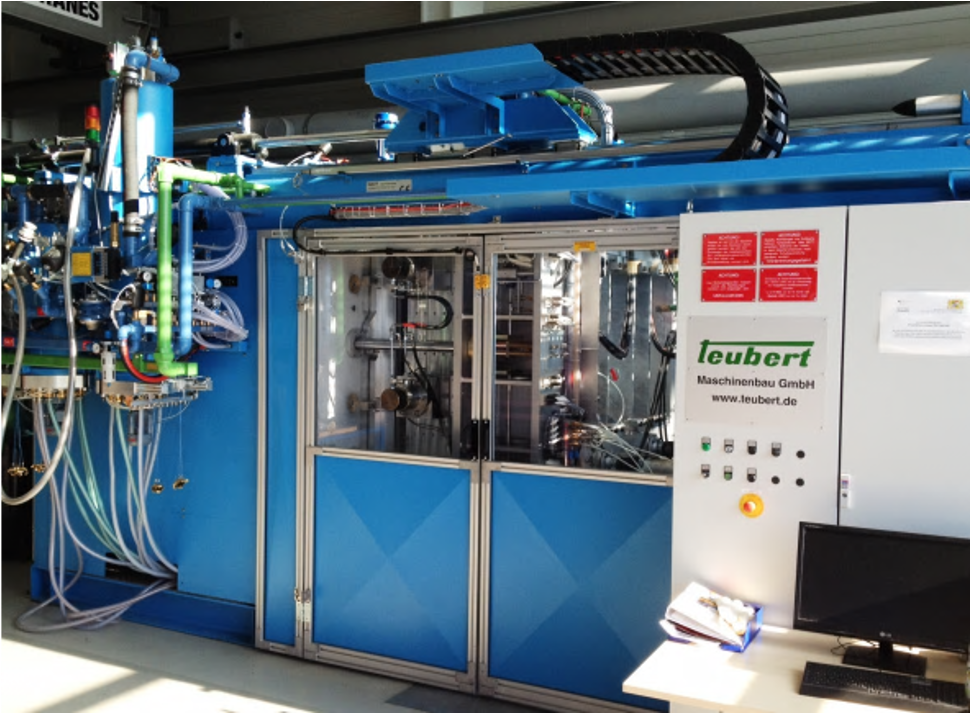
| Internal Steam Chamber Pressure [bar] | 5 |
| Silovolume [L] | Silo 1 (Standard): 300
Silo 2 (Liquid Air): 150 Silo 3 (Standard with hinged Floor): 30 Silo 4 (Eco-Pulse-Technology): 18 |
| Tool Dimensions [mm] | |
| Standard Technology: | 1000 x 600 x 90/300/500 |
| Monoblock Technology: (with and without surface graining) |
290 x 200 x 3/6/9/50 |
| Optional | Vacuum System Pressure loading System mit 2 x 1,5 m³ Volume |
Property of Neue Materialien Bayreuth GmbH
Location: Neue Materialien Bayreuth GmbH
BThe Collin extrusion line is a tandem setup consisting of a ZK 25 P twin-screw extruder and an E 45 M single-screw extruder. The other equipment includes a melt pump, gravimetric feeders, a gas metering station, and a pump for liquid metering (e.g. blowing agent).
With this plant, granulate and micro-granulate of various sizes can be produced, but also foamed materials and particle foams. In the case of foamed particles, the blowing agent-laden melt is fed through the perforated plate of the underwater pelletiser via an adapter and is then granulated by a rotating cutter head. A water pressure of up to 10 bar can be set here. The speed of the knives can also be adjusted. The cut granulate, foamed or unfoamed, is conveyed through a pipe system into a dryer.
We are currently using the system primarily for foam extrusion and particle foam production on a technical scale.
TWIN-SCREW EXTRUDER
Screw Diameter [mm] 25
Barrel Length [d] 42
Processing Temperatures [°C] bis 450
Throughput [kg/h] bis 15
Torque [Nm] 90
Speed [1/min] 460
Processing Methods
Compounding, Foam Extrusion, Bead Foaming
Features
Collin Profile Calibrator, Maximator, Wide Slit-Die, Two-Component Dosing Unit
SINGLE-SCREW COOLING EXTRUDER
Screw Diameter [mm] 45
Barrel Length [d] 30
Processing Temperatures [°C] bis 450
Throughput [kg/h] bis 15
Torque [Nm] 1200
Speed [1/min] 240
Processing Methods
Compounding, Foam Extrusion, Bead Foaming
Location: University of Bayreuth

The LÖDIGE Laboratory Plowshare-Mixer enables the homogeneous coating of even light particle foams with a wide variety of powders and/or liquids. Especially for the further processing to molded parts, a coating is often relevant, which improves the welding of individual beads or makes it possible in the first place. Highly viscous fluids can also be processed by a heated drum. The connection of the mixer to a central data storage allows a traceable and constant quality. Special EX protection with nitrogen flooding and temperature monitoring of the seals means that explosive dusts or liquids can also be processed.
Maximum temperature [°C] 158
Usable volume [L] 3-7
Rotational speed [1/min] 30-300
Location: University of Bayreuth
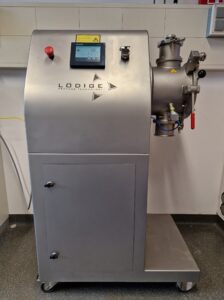
This tandem extrusion line consists of a co-rotating twin-screw extruder and a single-screw extruder. At the end of the single-screw extruder, another single screw can be coupled via a co-extrusion block and the plant can be expanded to a tridem plant.
The line was funded as part of a research project for the production of a thermoplastic printed circuit board. The aim was to produce a three-layer substrate material for conventional printed circuit boards, the core of which consisted of foamed thermoplastic and the cover layers of compact high-temperature thermoplastic. Of course, this plant configuration can also be used to process other thermoplastics.
We are currently using the system primarily in a tandem configuration for foam extrusion and particle foam production on a pilot plant scale.
TWIN-SCREW EXTRUDER
Screw Diameter [mm] 41
Barrel Length [d] 43
Processing Temperatures [°C] up to 400
Throughput [kg/h] up to 50
Processing Methods
Compounding, Foaming, Co-Extrusion, Bead Foaming
Features
Collin Smoothing-Unit, Lewa-Pump, Granulator, Slit-Die, Co-Extrusion Die
COOLING EXTRUDER
Screw Diameter [mm] 50
Barrel Length [d] 30
Processing Temperatures [°C] up to 400
Features
Collin Smoothing-Unit, Lewa-Pump, Granulator, Slit-Die, Co-Extrusion Die
CO-EXTRUDER
Screw Diameter [mm] 50
Barrel Length [d] 30
Processing Temperatures [°C] up to 400
Features
CCollin Smoothing-Unit, Lewa-Pump, Granulator, Slit-Die, Co-Extrusion Die
Location: Neue Materialien Bayreuth GmbH
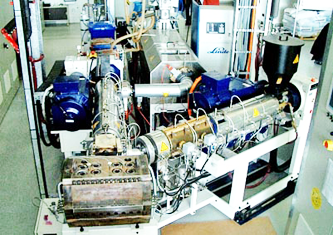
The cost-efficient production of injection moulded parts requires the shortest possible cycle times, which are in the range of just a few seconds for mass-produced articles.
For this purpose, we use the hybrid injection moulding machine Arburg Allrounder 470 H 1000 – 170, which combines electric speed with hydraulic power.
The Arburg 470 H 1000 – 170 is the ideal injection moulding machine short cycle times and high precision with very thin walls are required. In addition, thanks to the installed ProFoam unit, the machine has the option of thermoplastic foam injection moulding (TSG). This combination allows, for example, foamed thin-walled articles to be produced with very short cycle times.
Clamping Unit Servo-electric
Clamping Force [kN] 1.000
Clear Distance between Tie Bars [mm] 470
Minimum installation Height [mm] 250
Maximum Plate Distance [mm] 850
Maximum Processing Temperature [°C] 450
Physical Blowing Agent N2 oder CO2
Injection Unit 170
Screw Diameter [mm] 30
Effective Screw Length [L/D] 20
Maximum Injection Volume [cm3] 85
Maximum Injection Pressure [bar] 2000
Maximum Shot Weight [g PS] 77
Maximum Loading Pressure [bar] 50
Location: University of Bayreuth
